 | | | Switch to: Europe, USA, New Zealand, Antarctica Credit: NOAA/Ovation  Planetary K-index Planetary K-index
Now: Kp= 0.33 quiet
24-hr max: Kp= 3.00 quiet
explanation | more data
Interplanetary Mag. Field
Btotal: 4.80 nT
Bz: 1.53 nT north
more data: ACE, DSCOVR
Updated: Today at 1147 UT  Coronal Holes: 04 Jun 24 Coronal Holes: 04 Jun 24 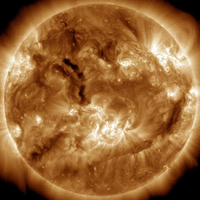
There are no equatorial coronal holes on the Earthside of the sun. Credit: SDO/AIA  Polar Stratospheric Clouds
Colorful Type II polar stratospheric clouds (PSC) form when the temperature in the stratosphere drops to a staggeringly low -85C. NASA's MERRA-2 climate model predicts when the air up there is cold enough: 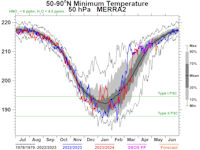
On June 3, 2024, the Arctic stratosphere is much too warm for Type II polar stratospheric clouds. | more data. Noctilucent Clouds
They're back! The northern season for NLCs is underway. The first clouds were detected inside the Arctic Circle on May 25, 2024, by the NOAA 21 satellite. The clouds have since spread, and now observers are seeing from the ground as well:
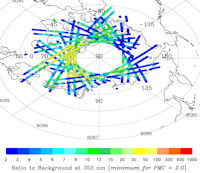
Updated: June 2, 2024
An instrument onboard NOAA 21 (OMPS LP) is able to detect NLCs (also known as "polar mesospheric clouds" or PMCs). IN the daily map, above, each dot is a detected cloud. As the season progresses, these dots will multiply in number and shift in hue from blue to red as the brightness of the clouds intensifies.
 SPACE WEATHER
NOAA Forecasts | | Updated at: 2024 Jun 04 2200 UTC FLARE | 0-24 hr | 24-48 hr | CLASS M | 60 % | 60 % | CLASS X | 25 % | 25 % |  Geomagnetic Storms: Geomagnetic Storms:
Probabilities for significant disturbances in Earth's magnetic field are given for three activity levels: active, minor storm, severe storm Updated at: 2024 Jun 04 2200 UTC Mid-latitudes | 0-24 hr | 24-48 hr | ACTIVE | 35 % | 10 % | MINOR | 10 % | 01 % | SEVERE | 01 % | 01 % | High latitudes | 0-24 hr | 24-48 hr | ACTIVE | 15 % | 15 % | MINOR | 30 % | 20 % | SEVERE | 45 % | 20 % | | | |  | | | | | | | | | | | This is an AI Free Zone! Text created by Large Language Models is spreading rapidly across the Internet. It's well-written, artificial, frequently inaccurate. If you find a mistake on Spaceweather.com, rest assured it was made by a real human being. | | | CME STRIKE SPARKS AURORAS IN THE USA: As predicted, a CME grazed Earth's magnetic field on June 3rd (2300 UT). The glancing blow sparked a minor G1-class geomagnetic storm with a brief display of auroras over Wisconsin: 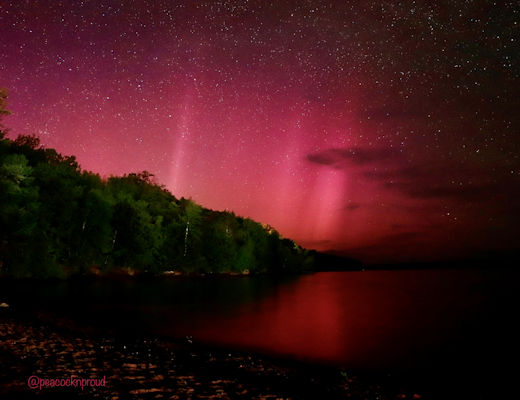
"While I was capturing images of the Milky Way I glanced to the north and saw these auroras low on the horizon," reports photographer Jim Peacock. "Sadly, they did not last long." The storm is over now and, until the next big flare, no more CMEs are heading our way. CME impact alerts: SMS Text Realtime Aurora Photo Gallery
Free: Spaceweather.com Newsletter
THE ANTI-TAIL OF COMET 12P (UPDATED): Comet tails are supposed to point *away* from the sun. Comet 12P/Pons-Brooks just sprung a tail in the opposite direction--an anti-tail. It's the narrow spike pointing toward the sun in this picture taken June 3rd by amateur astronomers Michael Jäger, Gerald Rhemann and Lukas Demetz: 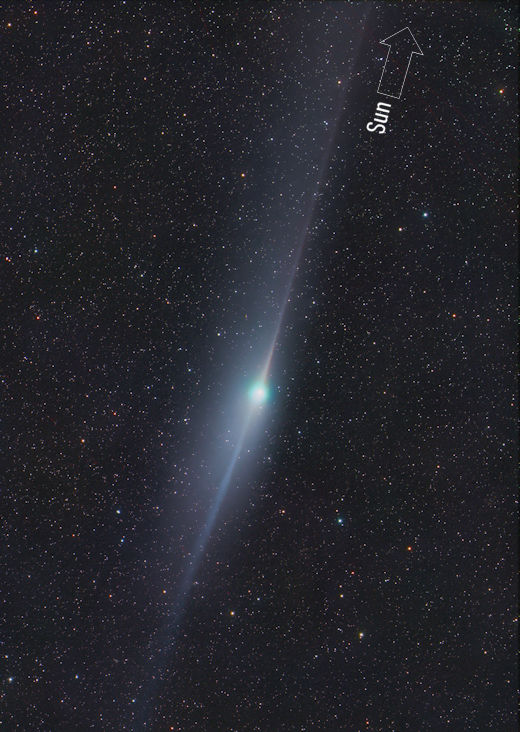
Anti-tails are an optical illusion. They appear when Earth passes through a comet's orbital plane, which, for Comet 12P, is happening this week. During the crossing, the sharp edge of the comet's fan-shaped dust tail appears to point toward the sun. "Earth crosses the comet's orbital plane on June 6th, so we will see this 'neck-line' structure for several more days," says Jäger. Comet 12P (magn. +7) is not visible to the naked eye, but it is an easy target for amateur telescopes. Southern hemisphere astronomers can find the comet in the constellation Lepus about 20 degrees below the celestial equator. The antitail will narrow in the days ahead, reaching maximum sharpness on June 6th. If you see it, submit your photos here. more images: from Giovanni Pesenti of Chacras Porvenir, Uruguay; from Daelman David of Rooisand Desert Ranch, Namibia Realtime Comet Photo Gallery
Free: Spaceweather.com Newsletter RARE LT. UHURA MUG (COLLECTOR'S ITEM):You can't buy this on Amazon. Only the Earth to Sky Store has the rare Lt. Uhura Coffee Mug. Like the great translator of Star Trek, it has been to space: 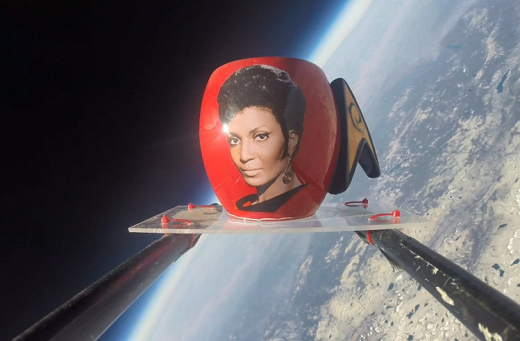
This 16 oz. ceramic mug featuring the face of Nichelle Nichols has flown to the stratosphere onboard an Earth to Sky Calculus cosmic ray balloon. At the apex of the flight, it floated 92,192 feet above the Sierra Nevada mountains of central California. You can have it for $170.10 (the serial number of the Enterprise divided by 10). It comes with a greeting card showing the mug in flight and telling the story of its journey to the edge of space and back again.
Far Out Gifts: Earth to Sky Store
All sales support hands-on STEM education
Realtime Space Weather Photo Gallery
Free: Spaceweather.com Newsletter
Realtime Aurora Photo Gallery
Free: Spaceweather.com Newsletter
Every night, a network of NASA all-sky cameras scans the skies above the United States for meteoritic fireballs. Automated software maintained by NASA's Meteoroid Environment Office calculates their orbits, velocity, penetration depth in Earth's atmosphere and many other characteristics. Daily results are presented here on Spaceweather.com. On Jun 04, 2024, the network reported 18 fireballs.
(18 sporadics) 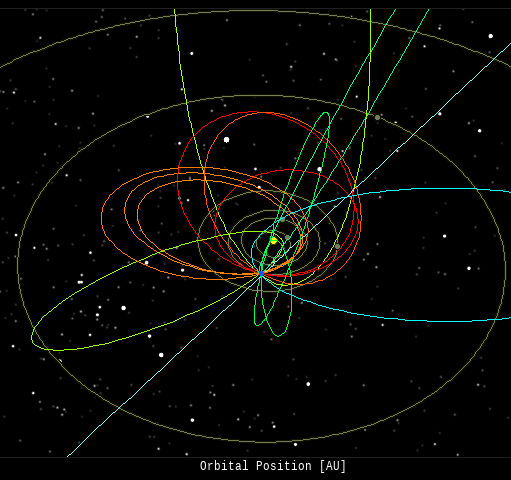 In this diagram of the inner solar system, all of the fireball orbits intersect at a single point--Earth. The orbits are color-coded by velocity, from slow (red) to fast (blue). [Larger image] [movies] Potentially Hazardous Asteroids ( PHAs) are space rocks larger than approximately 100m that can come closer to Earth than 0.05 AU. None of the known PHAs is on a collision course with our planet, although astronomers are finding new ones all the time. On June 4, 2024 there were 2349 potentially hazardous asteroids.
 | Recent & Upcoming Earth-asteroid encounters: | Asteroid | Date(UT) | Miss Distance | Velocity (km/s) | Diameter (m) | | 2024 JA3 | 2024-May-30 | 6.2 LD | 8.5 | 36 | | 2024 LB | 2024-May-30 | 7.8 LD | 5.2 | 11 | | 2024 KY | 2024-May-30 | 3.7 LD | 7.2 | 19 | | 2024 KX | 2024-May-31 | 0.8 LD | 8.3 | 10 | | 2008 XH | 2024-May-31 | 13.8 LD | 14.7 | 82 | | 2024 KB1 | 2024-Jun-01 | 1 LD | 11.1 | 8 | | 2024 JP1 | 2024-Jun-01 | 18.5 LD | 4.7 | 24 | | 2024 JC1 | 2024-Jun-01 | 15.1 LD | 4.8 | 34 | | 2024 KO1 | 2024-Jun-01 | 7.2 LD | 7 | 13 | | 1998 KY26 | 2024-Jun-01 | 12 LD | 5.3 | 25 | | 2016 JC6 | 2024-Jun-01 | 19.9 LD | 7.1 | 189 | | 2024 KZ | 2024-Jun-03 | 11.5 LD | 9.9 | 36 | | 2024 KT1 | 2024-Jun-03 | 4.8 LD | 7.2 | 14 | | 2024 LM | 2024-Jun-03 | 2.5 LD | 6.6 | 9 | | 2024 KA2 | 2024-Jun-04 | 0.9 LD | 13.1 | 9 | | 2024 KK1 | 2024-Jun-04 | 11.2 LD | 4.6 | 21 | | 2024 KX1 | 2024-Jun-04 | 3.5 LD | 10.7 | 16 | | 2024 JR17 | 2024-Jun-05 | 19.3 LD | 14.5 | 84 | | 2008 YN2 | 2024-Jun-05 | 10.5 LD | 7.7 | 20 | | 2021 LW3 | 2024-Jun-06 | 9.7 LD | 9.8 | 86 | | 2024 KA1 | 2024-Jun-07 | 4.9 LD | 8.3 | 30 | | 2024 LA | 2024-Jun-07 | 4.7 LD | 18.3 | 25 | | 2024 LC | 2024-Jun-08 | 12.3 LD | 8.7 | 27 | | 2024 CR9 | 2024-Jun-11 | 19.2 LD | 7.4 | 451 | | 2024 LD | 2024-Jun-11 | 12.1 LD | 10.7 | 21 | | 2022 XC1 | 2024-Jun-12 | 16.5 LD | 6.5 | 21 | | 2022 WW11 | 2024-Jun-17 | 19.7 LD | 14.4 | 15 | | 2024 KW1 | 2024-Jun-17 | 19.9 LD | 4 | 28 | | 2024 KY1 | 2024-Jun-19 | 16.1 LD | 12.2 | 36 | | 2024 LJ | 2024-Jun-21 | 8.9 LD | 18.5 | 72 | | 2024 KN1 | 2024-Jun-23 | 14.7 LD | 4.6 | 28 | | 2024 KJ | 2024-Jun-25 | 13.7 LD | 4.5 | 25 | | 2019 NJ | 2024-Jun-27 | 17.2 LD | 10.1 | 66 | | 415029 | 2024-Jun-27 | 17.3 LD | 25.9 | 2304 | | 2022 MM1 | 2024-Jun-28 | 7.8 LD | 10.9 | 39 | | 2010 XN | 2024-Jun-28 | 14.1 LD | 11.3 | 52 | | 2022 HD1 | 2024-Jun-29 | 17.3 LD | 7.2 | 63 | | 2017 MB3 | 2024-Jun-30 | 5 LD | 6.5 | 30 | | 2024 JJ25 | 2024-Jun-30 | 10.5 LD | 9.4 | 117 | | 2022 BY39 | 2024-Jul-02 | 13.2 LD | 3 | 4 | | 2024 LH | 2024-Jul-03 | 4.5 LD | 4.2 | 32 | | 2024 KQ1 | 2024-Jul-04 | 15.2 LD | 6.8 | 57 | | 2022 YS5 | 2024-Jul-11 | 11 LD | 5.8 | 38 | | 2024 BY15 | 2024-Jul-16 | 16.2 LD | 0.7 | 16 | | 2011 MW1 | 2024-Jul-25 | 10.1 LD | 8 | 120 | | 2011 AM24 | 2024-Jul-26 | 16.8 LD | 6.2 | 281 | | 523664 | 2024-Jul-28 | 14.9 LD | 23.7 | 680 | | 2020 PN1 | 2024-Aug-02 | 18 LD | 5.5 | 29 | Notes: LD means "Lunar Distance." 1 LD = 384,401 km, the distance between Earth and the Moon. 1 LD also equals 0.00256 AU. | | Cosmic Rays in the Atmosphere | SPACE WEATHER BALLOON DATA: Almost once a week, Spaceweather.com and the students of Earth to Sky Calculus fly space weather balloons to the stratosphere over California. These balloons are equipped with sensors that detect secondary cosmic rays, a form of radiation from space that can penetrate all the way down to Earth's surface. Our monitoring program has been underway without interruption for 7 years, resulting in a unique dataset of in situ atmospheric measurements. Latest results (July 2022): Atmospheric radiation is decreasing in 2022. Our latest measurements in July 2022 registered a 6-year low: 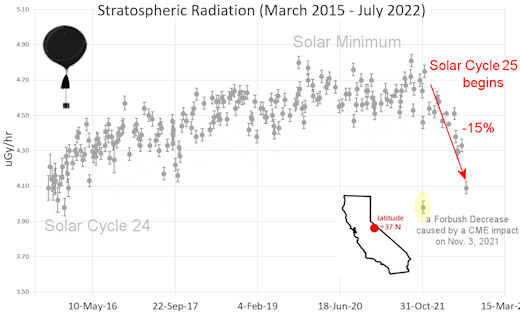
What's going on? Ironically, the radiation drop is caused by increasing solar activity. Solar Cycle 25 has roared to life faster than forecasters expected. The sun's strengthening and increasingly tangled magnetic field repels cosmic rays from deep space. In addition, solar coronal mass ejections (CMEs) sweep aside cosmic rays, causing sharp reductions called "Forbush Decreases." The two effects blend together to bring daily radiation levels down. .Who cares? Cosmic rays are a surprisingly "down to Earth" form of space weather. They can alter the chemistry of the atmosphere, trigger lightning, and penetrate commercial airplanes. According to a study from the Harvard T.H. Chan school of public health, crews of aircraft have higher rates of cancer than the general population. The researchers listed cosmic rays, irregular sleep habits, and chemical contaminants as leading risk factors. A number of controversial studies (#1, #2, #3, #4) go even further, linking cosmic rays with cardiac arrhythmias and sudden cardiac death. Technical notes: The radiation sensors onboard our helium balloons detect X-rays and gamma-rays in the energy range 10 keV to 20 MeV. These energies span the range of medical X-ray machines and airport security scanners. Data points in the graph labeled "Stratospheric Radiation" correspond to the peak of the Regener-Pfotzer maximum, which lies about 67,000 feet above central California. When cosmic rays crash into Earth's atmosphere, they produce a spray of secondary particles that is most intense at the entrance to the stratosphere. Physicists Eric Regener and Georg Pfotzer discovered the maximum using balloons in the 1930s and it is what we are measuring today. | | The official U.S. government space weather bureau | | | The first place to look for information about sundogs, pillars, rainbows and related phenomena. | | | Researchers call it a "Hubble for the sun." SDO is the most advanced solar observatory ever. | | | 3D views of the sun from NASA's Solar and Terrestrial Relations Observatory | | | Realtime and archival images of the Sun from SOHO. | | | information about sunspots based on the latest NOAA/USAF Active Region Summary | | | current counts of failed and deployed Starlink satellites from Jonathan's Space Page. See also, all satellite statistics. | | | Authoritative predictions of space junk and satellite re-entries | | | from the NOAA Space Environment Center | | | fun to read, but should be taken with a grain of salt! Forecasts looking ahead more than a few days are often wrong. | | | from the NOAA Space Environment Center | | | the underlying science of space weather |  | Got a chipped or cracked windshield that prevents you from seeing space weather events while driving? Get windshield replacement from SR Windows & Glass with free mobile auto glass service anywhere in the Phoenix area. |  | Marketing yourself on YouTube is hard without real organic views on your videos. You can buy organic YouTube views from and enjoy social boosting that is actually real. Highly recommended! |  | When looking for casinos to play online when the weather is bad, you can try the SkyCity Online Casino if you are located in New Zealand. If you are not from NZ you can try the Swedish page Svenska casino online to find suitable games, check out svenskacasinoonline.net. Always check your local laws before playing with real money.. |  | BestCSGOGambling is the best site for everything related to CSGO gambling on the web | | | These links help Spaceweather.com stay online. Thank you to our supporters! | | | | | | | | |  | |  |   | ©2021 Spaceweather.com. All rights reserved. This site is penned daily by Dr. Tony Phillips. | |

